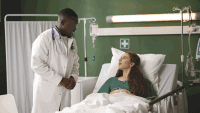The escalation in the complexity of med-surg patients has resulted in the need for a bedside tool that measures acuity. Such tools have been limited. Some existing tools analyze active patient orders to calculate acuity, but fail to recognize psychosocial issues, patient education, and other time-consuming bedside nursing interventions. Others are geared toward special patients populations, like the Oncology Acuity Tool. In 2007, the Association of UK University Hospital Systems developed the AUKUH Acuity/Dependency Tool. This tiered acuity tool is used by the bedside nurse to assign acuity ratings across a broad range of units. However, this tool has had limited use in the U.S.
In this article, I describe a pilot project for developing a new acuity tool: Acuity Measurement & Assessment of Patients (A-MAP). Although more research is needed, the tool has proven to be effective for assessing acuity and is easy to use.
A tool is born
On each shift at the hospital where I work, the charge nurse collects acuity information such as restraints, pressure ulcers, patients on 1:1 observation, pain management, tracheostomy care, isolation precautions, nasogastric tubes, and percutaneous endoscopic gastrostomy (PEG) or jejunostomy (PEJ) tubes, to name a few. Ideally, the charge nurse was to make assignments based on acuity, but in reality assignments were based on blocks of rooms because of time constraints.
I began to develop the A-MAP by creating a list of acuity measurements frequently encountered on our unit and breaking them into three categories. During a shared governance meeting with staff RNs, we brainstormed about the types of patient acuity and level of required care. For example, levels of oxygen support, pain medication frequency, challenging patient and family behaviors requiring more frequent nursing interventions, were listed and later distributed into three categories of green, yellow, and red, from least to most challenging patients. A green, yellow, and red magnet would later represent each of the three categories from least to most acutely ill on the patient assignment board at the nurses’ station. For example, IV pain management greater than every 6 hours is a GREEN patient, every 4-6 hours is a YELLOW patient, and every 2-3 hours is a RED patient.
To capture nonmedical related challenges, we placed psychiatric patients with a dual diagnosis of substance abuse and mental disorder in the RED category to reflect the difficult nature of nursing for this group of patients and the amount of time a nurse spends intervening with this population throughout the day. Psychosocial issues, such as psychiatric patients and patients actively withdrawing from drugs or alcohol, were listed as RED. To capture the challenging behaviors of patients and their families, a patient was assigned a RED level if challenging patient and family behaviors were present and a YELLOW rating if challenging patient or challenging family behaviors were present.
Ultimately, we finalized the tool. (Download a PDF of the A-MAP.) In summary:
- GREEN patients are fairly self-sufficient, require standard IV antibiotic therapy, rule out myocardial infarction (two confirmed negative troponin tests), electrolyte repletion, heart failure exacerbation, can walk in the hallway, and are waiting discharge.
- YELLOW patients are pending multiple procedures and leaving the floor for tests, require pain control every 4-6 hours, and need standard wound care. Their needs are met through baseline resources.
- A RED patient is an unstable patient (fluctuating vitals signs, uncontrolled pain or pain medication every 2-3 hours, or requiring more than baseline resources. (See Baseline Resources.)
| Baseline resources Baseline resources are defined as patients’ needs met through regular rounding and one nurse and/or nurse aide are able to quickly address patients’ needs. More than baseline resources are patients requiring more than one nurse and/or nurse aide, interventions are time consuming and occur outside of regular rounding. For example, complex wound care involving negative-pressure wound therapy or multiple pressure ulcer dressings require a significant amount of time. |
Roll-out
Ideally, one person should perform acuity ratings to achieve better consistency. However, on my unit, the charge nurse has a full patient load so adding the responsibility of assigning acuity ratings to all the patients was not feasible. Instead, during each day and night shift the nurse caring for the patient assigns the acuity rating. A better option would be to have a charge nurse without a patient assignment to fulfill this role.
We rolled the tool out in stages. Initially, the charge report was amended to reflect acuity measurements such as bed alarms, central lines, and blood products. The miscellaneous column was expanded to include any type of apparatus that a nurse would have to drain, measure, flush, provide education on, or otherwise intervene.
I educated all nurses about the tool and explained the definition of “baseline resources.” I gave nurses a description of a patient and asked them to classify the patient as GREEN, YELLOW, or RED and place the corresponding colored magnet on the assignment board next to the patient’s name. (See Sample patients.) Acuity assessment by all nurses throughout the orientation period was consistent. Frequent checks and audits were made to ensure reliability.
Sample patients
|
Evaluation: What are nurses saying?
During the first day of rollout the charge nurse didn’t use the acuity tool to create the assignment, and one nurse was given three red patients. After close examination of the three patients, it was determined that all three were indeed RED, and they should be split among three staff members. Empowered by the acuity tool, the assignment was changed to reflect a more fair and balanced assignment.
In the beginning, there was a tendency for nurses to assign acuity based on their definition of an easy, medium, or difficult patient. Morning huddles and emails reminding nurses to use the tool and not their opinions helped to change this practice.
Since the initiation 6 months ago, nurses have reported feeling the assignments have been more fair and balanced with an even distribution of the challenging patients. At first, nurses hesitate to give patients a RED rating because they didn’t want to “scare” the oncoming nurse, but this resolved over time, without any needed intervention overtime.
Charge nurses find the tool helpful in creating an easy visual of the location of the RED patients. The color-coded magnet system on the assignment board creates a visual map of the acuity of the unit for quick and easy reference while making the nursing assignments. On the downside, given the large size of our unit and the geographic difficulties maneuvering around a U-shaped unit, nursing assignments are more spread out and may require moving from one end of the unit to the other. However, nurses feel that the control over acuity and distribution of challenging patients outweighs this negative consequence. Use of the tool has expanded to two other med-surg units.
Achieving excellence
A thorough assessment of patients’ needs is vital to achieve excellence in patient care. Empowering bedside medical surgical nurses to assess acuity enables them to enhance patient care through the identification of challenging patients and may ultimately improve retention. Although more study is needed, A-MAP may be a valuable tool that identifies patient and nursing requirements so that patient care and satisfaction are improved and nurses are more satisfied with their work.
Selected references
Brennan CW, Daly BJ, Dawson NV, et al. The oncology acuity tool: a reliable, valid method for measuring patient acuity for nurse assignment decisions. J Nurs Meas. 2012;20(3):155-85.
Smith J. How to keep score of acuity and dependency. Nurs Management. 2009;16(8):14-19.
The Association of UK University Hospitals. Patient care portfolio: AUKUH Acuity/Dependency tool implementation resource pack. www.aukuh.org.uk
Paul Andrew Jones is a senior staff nurse in the medical ICU at New York Presbyterian, Weill Cornell Medical Center. He worked in general medicine at the time this article was written.



















1 Comment.
I think this is a great idea and intend to put to management at the next staff meeting, thank you.